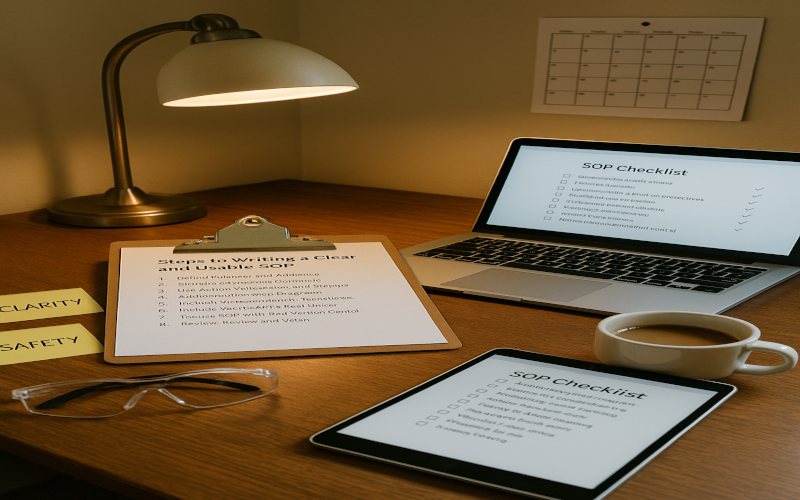Heads up: This post may have affiliate links. As an Amazon Associate, I earn from qualifying purchases.

8 Steps to Writing a Clear and Usable SOP
Standard Operating Procedures, or SOPs, may not sound glamorous, but they’re the unsung heroes of business operations. Whether you’re onboarding new employees, ensuring safety in a lab, or keeping customer service consistent, a well-written SOP can be the difference between smooth sailing and total chaos.
Here’s the thing though: not all SOPs are created equal. Too many are confusing, overly wordy, or missing critical details making them more frustrating than helpful.
If you want your SOPs to actually work (and not just collect digital dust in a folder), they need to be clear, usable, and easy to follow. Here are 8 steps to writing SOPs that people will actually use.
1. Define the Purpose and Audience
Before you start writing, get clear on two things:
-
Why does this SOP exist?
-
Who is it for?
An SOP for factory floor staff will look very different from one for office administrators. Understanding your audience determines the level of detail, tone, and vocabulary.
Pro tip: Include a short “Purpose” section at the beginning of your SOP so readers instantly know what the document is for.
2. List Materials, Tools, or Prerequisites
Ever tried following instructions only to realize halfway through that you’re missing a tool? Frustrating, right?
A great SOP avoids that headache by listing all materials, tools, or requirements before the steps begin.
Examples:
-
“Safety gloves, goggles, and apron”
-
“Admin-level access to the software”
-
“Printer connected to the local network”
This simple step saves time, reduces errors, and makes the process more user-friendly.
3. Use Action Verbs and Numbered Steps
Your SOP isn’t a novel it’s an instruction guide. Every step should start with a clear action verb:
-
“Open the valve”
-
“Press the green button”
-
“Save the file as PDF”
Pair those verbs with numbered steps so readers know exactly what to do, in the correct order. Avoid vague phrases like “configure the system” without specifying how.
4. Format for Quick Scanning
No one wants to read through walls of text when they’re trying to do a task. Formatting can make or break an SOP.
Best practices include:
-
Headings and subheadings for sections
-
Bold keywords or warnings
-
Bulleted or numbered lists
-
Short, simple paragraphs
Your goal is to make information easy to find at a glance especially for users under time pressure.
5. Add Visuals or Diagrams
A picture really can save a thousand words. Sometimes, the fastest way to explain a process is to show it.
Consider adding:
-
Diagrams of machinery
-
Flowcharts for decision points
-
Screenshots for software steps
-
Labels and arrows to highlight key details
Always pair visuals with brief captions so readers understand what they’re looking at.
6. Include Warnings or Safety Notes
If missing a step could cause injury, damage, or costly mistakes, flag it clearly.
Examples:
-
⚠️ Warning: Always disconnect power before performing maintenance.
-
❗ Note: Enter the correct file path to avoid system errors.
Consistency is key use icons, bold text, or color coding so safety notes stand out every time.
7. Test the SOP with Real Users
Here’s a mistake too many organizations make: they write SOPs in a bubble and never test them.
The best way to see if your SOP works? Hand it to someone from the target audience and watch them use it. Take notes:
-
Do they understand the steps?
-
Where do they hesitate or get stuck?
-
Are any details missing?
Testing ensures your SOP is usable in the real world, not just on paper.
8. Review, Revise, and Version Control
An SOP isn’t a “set it and forget it” document. Processes, tools, and regulations change and your SOPs need to keep up.
Best practices:
-
Schedule regular reviews (every 6–12 months)
-
Track changes with version numbers
-
Date each revision for transparency
-
Archive old versions for reference
This way, your SOPs stay current, accurate, and trustworthy.
SOPs That Actually Work
A clear and usable SOP is more than a document it’s a tool that empowers people to do their jobs confidently and consistently. By following these eight steps, you’ll create SOPs that are easy to read, easy to follow, and impossible to ignore.
Remember: the best SOPs don’t just sit in a binder or on a server they actively make work safer, smoother, and more efficient.
